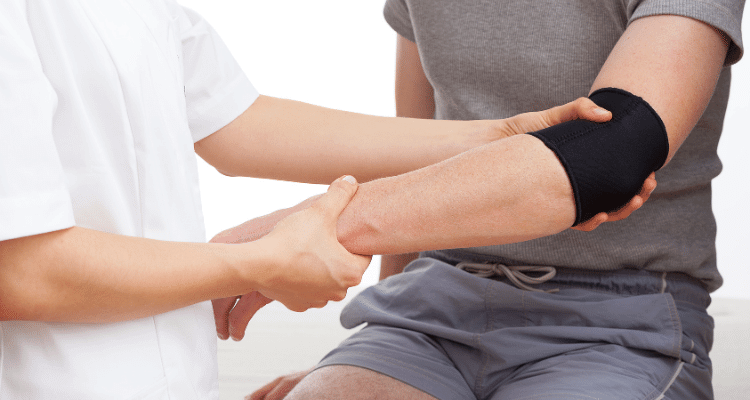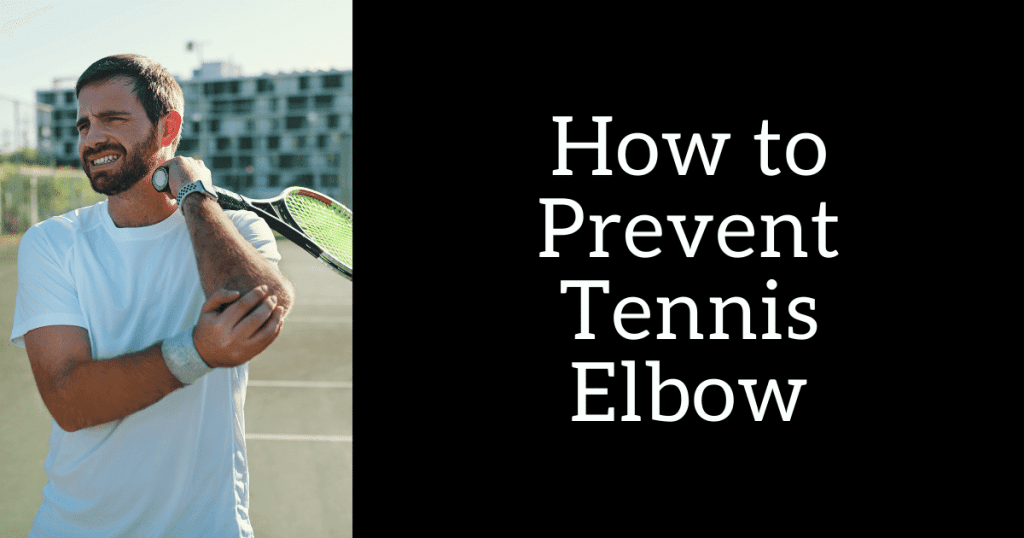If you are a tennis player, you are probably well aware of tennis elbow. It is a painful and frustrating condition that, unfortunately, tennis players are at high risk of suffering from.
While tennis elbow is not restricted only to tennis players, the repetitive swinging motion that characterizes the sport is the type of movement that can trigger the condition.
Contents
What is Tennis Elbow?
Tennis elbow, or lateral epicondylitis, is an overuse injury that often results in inflammation and pain on the outside of the elbow and upper forearm.
In most cases, tennis elbow is triggered by repetitive arm motions that involve the tendons in the elbow.
These tendons extend and stabilize the wrist, as well as anchor your forearm muscles to the bone. When you swing a racket, you put stress on these tendons.
With enough stress, the tendons can begin to suffer from inflammation.
In most cases, this inflammation causes the sensation of tenderness and mild to severe pain in the elbow, especially when the individual attempts to make a fist or grasp an object.
![]()
Symptoms of Tennis Elbow
In addition to pain on the bony part of the elbow, those suffering from tennis elbow will often struggle to form a solid fist or lift anything heavy.
Essentially, inflammation can become so severe that the individual loses grip strength.
Other signs of tennis elbow include sharp bursts of pain whenever the elbow is bent, the sensation of numbness down the forearm, and even tingling in the fingertips.
Many people will also experience a dull and persistent ache throughout the arm and elbow.
Causes of Tennis Elbow
As mentioned above, tennis elbow is an overuse injury. It results from overusing the muscles and tendons in the arm. Several factors put a person at risk of developing tennis elbow.
As you would expect, the amount of stress you put on the tendons plays a significant role, as does your age and overall health.
Any activities that put stress on the tendon and forearm muscles can increase your chances of developing the condition, so you must manage your overall activity level, not just the amount of tennis you play.
Cases of tennis elbow can also be linked to other injuries that have impacted the tendons and arm muscles.
For example, if you suffer impact trauma to the elbow, the tendon could swell and even degrade to a point where you are at a much higher risk of developing tennis elbow in the future.
Unfortunately, there is also a genetic component to tennis elbow, as some people are born with weaker tendons that are much more prone to injury and overuse conditions.
How Can You Prevent Tennis Elbow?
As you would suspect, tennis elbow can be fairly debilitating and certainly reduces the amount of tennis a person can play.

The following are some of the best things you can do to prevent tennis elbow from ever appearing:
1. Stretch and Warm-Up Before You Play
Tennis elbow occurs when the muscles and tendons experience excessive stress. It is less likely that they will hit that stress point if properly conditioned.
You can do a lot to prevent tennis elbow just by warming up before you play tennis or engage in any other activity that puts stress on the lateral epicondyle tendon. Stretching the forearm muscles before you play will also help.
One of the best stretches you can do is holding your arm out directly in front of you with your palm facing the ground.
Use the other arm to press down on the outstretched hand until the fingers are pointing straight down. This is typically known as a wrist flexion stretch, and you should hold it for about 20 seconds per arm.
It is also worth building up your forearm muscles as this can also prevent some cases of tennis elbow. Any resistance training that forces the forearms to work will help build these muscles.
Best of all, building strength in the arms will help you play tennis better, as that increased strength can translate to a more powerful shot.
2. Use Proper Technique and the Right Equipment
Studies have shown that using improper equipment and regularly using an improper form can increase your risk of developing tennis elbow.
Is so important to choose an appropriately sized racket with the correct grip size for your hands. If you constantly have to squeeze your fist tight to hold a tennis racket that is too small or too large for your hands, you are putting unnecessary strain on your forearm muscles and tendons, which increases your risk of developing tennis elbow.
Not only does proper form reduce your risk of developing the condition, but it will also help prevent other tennis-related injuries.
Even if you have been playing for many years, consider taking a lesson or reaching out to an advanced player to make sure you are holding the racket correctly and swinging with the correct technique.
3. Loosen Your Grip
The less time you spend holding your racket with a firm grip, the less stress you are putting your injury-prone forearm muscles and tendons underneath.
While it can be difficult, you can give your muscles a break if you loosen your grip on your racket between hits. It can also help if you take breaks between games and allow your arms to recover.
The more time your muscles have to relax, the more chance they have to recover, which will reduce your chances of developing tennis elbow.
It is also important to manage your workload. If you participate in multiple activities that strain the tendons, such as painting, golf, tennis, weight lifting, and various forms of manual labor, you may want to take a couple of days off before you head to the tennis court.
4. Use KT tape
You may also want to try KT tape tennis elbow prevention. This sports tape is used by pros to support the elbow while playing. The brand has plenty of information available about how to place the tape for the best results.
This tape is hypoallergenic and free of rubber and latex, so it’s safe for your skin and won’t cause irritation or allergic reactions.
Nobody Wants to Suffer From Tennis Elbow
While it may seem unnecessary, practicing a few precautionary steps can go a long way towards preventing tennis elbow and reducing its severity.
Make sure you always warm up before you play and make an effort to manage the amount of stress you put on your arms and elbows.
If you have more questions about tennis elbow prevention, consider reading through this helpful guide from Harvard University’s Medical School titled Stop Elbow Pain and Stay in the Game.
If prevention didn’t occur and now you need a brace, check out our take on the best braces available.

